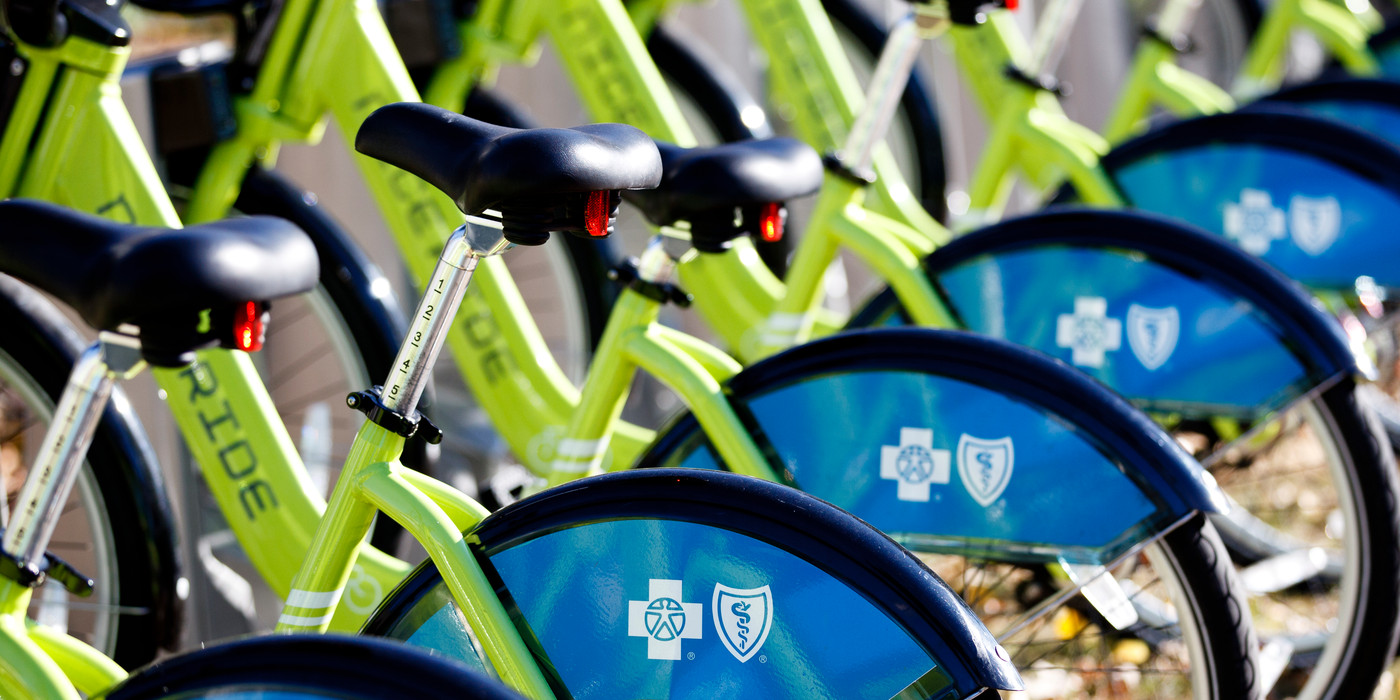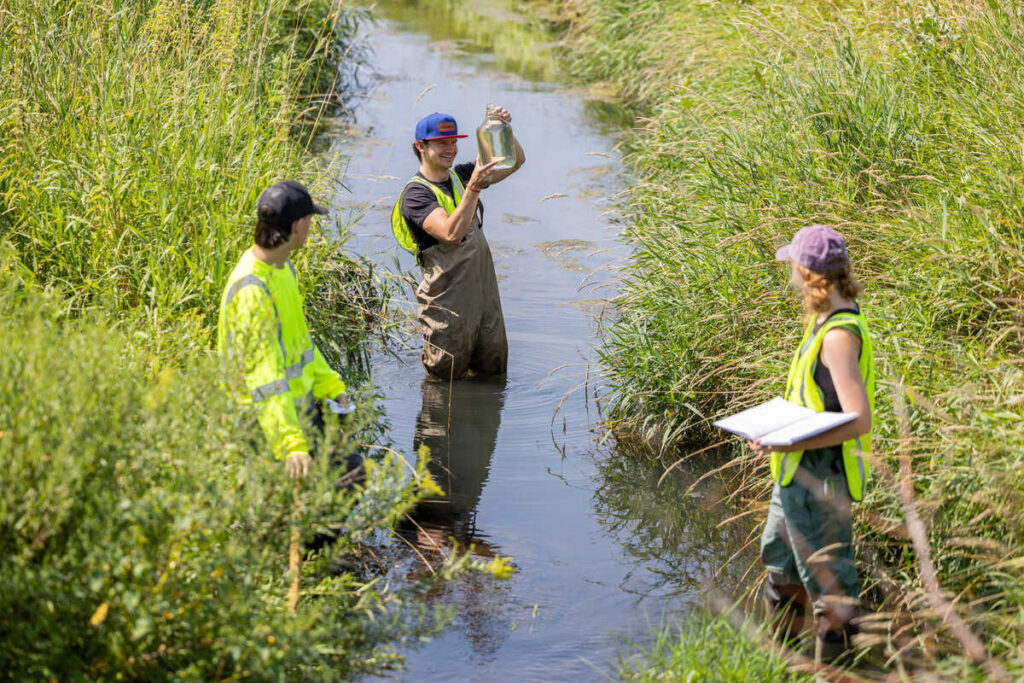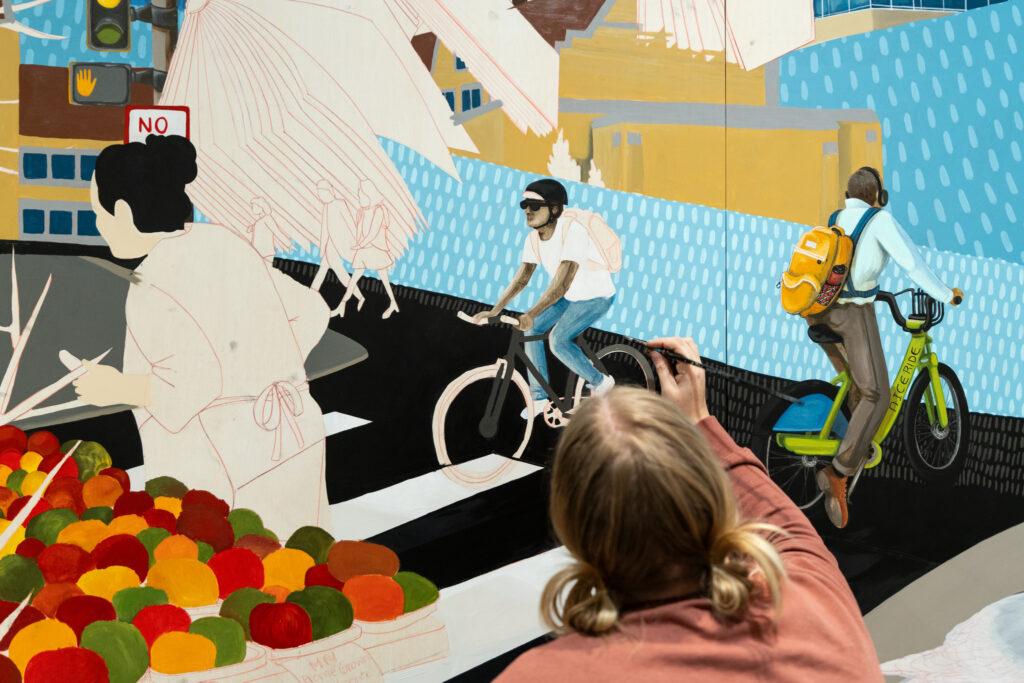For junior geography major Nick Ronnei, the hallmark of a sustainable city is a thriving bike share program. In fact, Minneapolis was named the most bike friendly city in the United States by Bicycling Magazine in 2010 – a title that Ronnei and senior Mitch Schaps have helped bolster through their research at St. Thomas.
Ronnei and Schaps work in the Geography Department’s Geographic Information Systems (GIS) lab as contractors with Nice Ride, the Twin Cities’ public bike sharing program. Through this partnership, they have mapped trade areas – the geographic areas expected to generate the majority of users for each station – for Nice Ride stations, analyzed patterns of bike use and calculated travel times from campus to local businesses.
A commitment to sustainability
Both Ronnei and Schaps never pictured themselves as geography majors, or as the current president and vice president of the Geography Club, respectively, but both credit Paul Lorah’s Human Geography class as the deciding factor.
The Nice Ride research was born out of Lorah’s fall 2012 Conservation Geography class, in which Ronnei, Schaps and other students wrote a grant application to the Campus Sustainability Fund – a component of St. Thomas’ pledge to be carbon neutral by 2035.
"All of this was on the backdrop of ‘How do you make a modern city work?’ So the grant fit nicely through that whole lens," Ronnei said.
Students asked for $20,000 to buy more than 650 annual Nice Ride subscriptions to be sold at a discounted price to members of the St. Thomas community. After the grant was approved, the students worked to publicize the program.
Schaps was encouraged by the positive student reaction to the passes. "The light bulb kind of clicked on – this could be a really useful resource for the campus."
With the initial success of the grant program, Schaps and Ronnei decided to take the project even further.
"Dr. Lorah talked to Nice Ride and asked them, ‘Would you want to work with us to develop a more interesting GIS project?’" Schaps said. Nice Ride agreed and the two students were hired as GIS lab interns last summer.
Why Nice Ride?
"Nice Ride opens up the neighborhood to students and makes things a lot more accessible, whether it’s riding to Highland Village or using the bike paths along the river. It makes it easier to be more active and encourages us to get outside more," Lorah said.
Schaps agrees, and suggests that a $10 per month Nice Ride membership can be cheaper than owning a car, or even buying a bike. And in this way, biking also promotes social equity.
"Nice Ride works with low-income communities to provide free passes. It opens up areas in North Minneapolis where people don’t have transit [and] they can’t get around, so you put a station in there and they have access to 170 different points in the city," Ronnei said.
For St. Thomas students, 2,500 businesses are suddenly accessible within a half hour travel time for those using Nice Ride bikes. "If you think about it in terms of someone looking for a job, that’s big," Ronnei said. "Those are some serious numbers.
"For me, it’s about changing the attitude. Twenty years ago, it was like, ‘Oh you’re taking your bike to work? What, you can’t afford a car?’ … This is a great way to just get people thinking about [biking] because it’s impossible not to notice somebody going by on a neon green bike," Ronnei said.
It's all about the data
St. Thomas has been Nice Ride’s biggest partner in terms of annual users, and the data collected through the bike rentals generates information that will be helpful in future planning.
Throughout the course of their research, Schaps and Ronnei have taken the network of Nice Ride stations in the Twin Cities and calculated the travel time between them, using ArcGIS – a program that uses digital mapping and analysis – to model use. They also have created a database of businesses in the area, categorized by type.
"We’re doing research that could help Nice Ride understand how riders use their stations," Lorah said. "And we’re talking with them about future research designed to target optimal locations for Nice Ride stations."
Mitch Vars, Nice Ride’s IT director, has enjoyed working with the students. "They’re doing the type of work that I dream of having free time to work on," Vars said. "I think that we’re going to see a great increase in ridership around campus this summer."
Nice Ride has not yet used the students’ research directly, but Vars is eager to see the research continue and make use of it in the future. "I think we’re going to be able to make use out of [the research] when we’re going out and promoting bike share to other institutions. … I hope that there are things we can make use of in time [and] extrapolate to the rest of the city beyond the St. Thomas campus," Vars said.
For instance, Schaps and Ronnei determined that students, faculty and staff took 3,994 trips and biked more than 5,387 miles using the Nice Ride system in the 2013 season – resulting in roughly 2.5 tons of total carbon savings.
Although they have studied only Nice Ride users who are from the St. Thomas community, their research can be applied to any business. "All you have to do is switch the starting point," Schaps said. "You can run the same exact analysis we did with all the rest of the Nice Ride stations, with your business as the starting point."
Prepackaging their research in this way, as well as finding a way to put the research online, is something Schaps is doing with the help of a Collaborative Inquiry Grant. The goal is to create a mobile app that students will be able to use to look up businesses accessible by bike, such as coffee shops within 10 minutes, or restaurants within 20 minutes.
Schaps said displaying the bike routes on a map also could show students how to get to places in the fastest amount of time, which could be a useful application as well.
There are "infinite possibilities," Ronnei said. "We’ll see which ones we can actually accomplish. But I wouldn’t be surprised to see a full-blown application by the end of the summer."
Gaining recognition
The students began to present their work as early as October 2012 at a conference attended by Surgeon General Regina Benjamin, who stopped to take a picture with them.
A year later, Schaps presented a poster based on their summer research with Nice Ride at the Minnesota GIS/LIS annual conference, and won the student poster competition.
The following week, Schaps and Ronnei traveled to Eau Claire, Wis., for the West Lakes Division Conference of the Association of American Geographers (AAG). After giving a 20-minute presentation on their research, the students were surprised to receive an exceedingly positive reaction from other attendees, including the heads of the Geography Department at Macalester College and the geography club from Bemidji State University. "They basically told us our project was what GIS was made for," Schaps said.
"They can go to a job interview and say … ‘Everybody’s worried about the environment – I actually went out and did something.’ This is the kind of project that gets them accepted to grad school and gets them funded," Lorah added.
A biking culture
Lorah believes the students’ work is also helping change campus culture. "I thought we would just get the grant, pass out some Nice Ride passes, track some use and be done with it, but it’s ongoing because students got interested in it."
Schaps and Ronnei agree that the work has been fulfilling. "It’s the exciting feeling of discovering something completely new. It’s cool because none of the things that we’re using are particularly groundbreaking, but it’s the creative way that we used them that actually made it something worth looking at," Ronnei said.
Ronnei aims to spend the summer in Alaska working with Resource Data Inc., one of the top GIS analysts. Schaps will continue the Nice Ride research throughout the summer and, after graduating in December, hopes to enroll in the Master of Geographic Information Science program at the University of Minnesota.
Schaps and Ronnei agree that there’s no better way to get to know the city than by making a conscious decision to bike. "The deliberate choice to bike instead of drive is something I think needs to happen for a lot more people," Ronnei said. "Change the way you think about the [transit] system is the moral of our whole story."
Read more from St. Thomas magazine.



